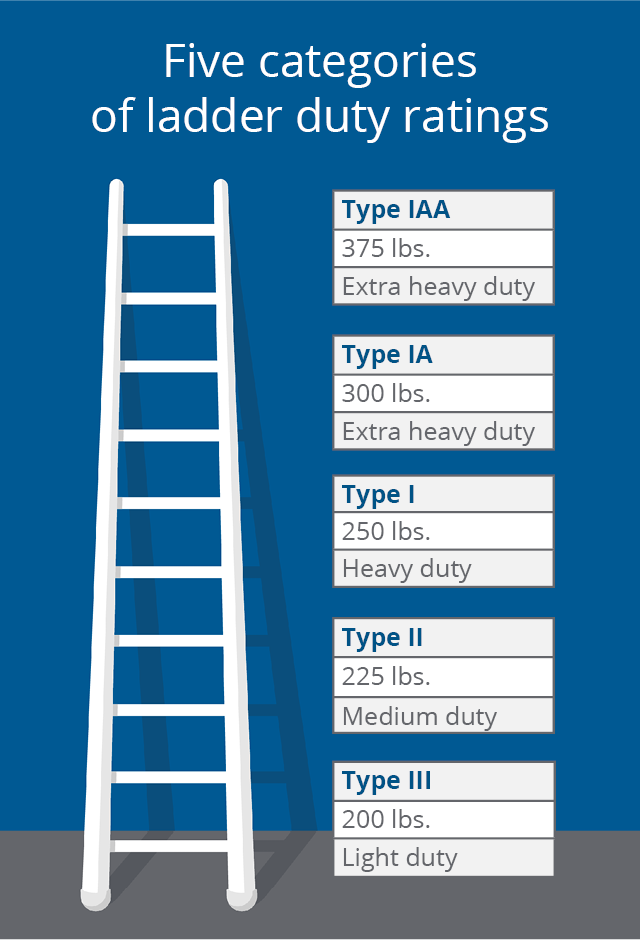Ladder safety: Climb safely
Almost every homeowner or business has a ladder in the garage or tool shed and uses it regularly. Unfortunately, many do not use it correctly.
According to the Bureau of Labor Statistics (BLS), in 2020 (the latest year for which these numbers are available), nearly 23,000 accidents and 160 deaths were attributable to ladder misuse. If you want to keep yourself or your employees from becoming statistics in the next BLS report, there are a few simple rules you should follow to keep everyone safe.
Pick the right ladder
All ladders are not created equal, and that means you need to be sure you’re using the right type for the job. First check its duty rating, a measure of how much weight a ladder will support when in use. The duty rating should handle your weight, plus the weight of the clothing you’re wearing, plus equipment, tools, parts, or supplies you will take with you up the ladder.

Then make sure you’re using the right style of ladder. These are some of the most common types:
Fixed or straight ladders are the most basic type. They have a fixed length and are not self-supporting, which means they must be leaned against a structure.
Extension ladders, like fixed ladders, are not self-supporting. They can be made taller, however, using a sliding section that extends from the base and then can be locked in place.
Stepladders are the type most people are familiar with. These self-supporting ladders are hinged at the top, are available in several heights, and often have a fold-out platform that will hold paint cans or tools while the user works aloft. Stepladders also generally feature hinged spreaders on either side, for added stability. They most often have flattened steps rather than the cylindrical rungs that are common in other ladder types.
Step stools are shorter than stepladders, and are also self-supporting. These have one or more steps that fold away beneath the seat when not in use.
Combination or multipurpose ladders can be used as fixed, extension, or stepladders. They may also be used as a trestle framework or set up in a stairwell. This type of ladder can be designed with either steps or rungs. The inclusion of a pail shelf is optional. When steps are present, the ladder should be erected so its step surfaces are horizontal. Either spreaders or a locking device can be used to securely hold the front and rear sections in the open position.
Ladder basics
Once you’ve settled on the right ladder for the right job and you’ve confirmed it can handle the load you anticipate, there are a few safety rules you need to follow.
- Be sure your ladder is on firm, level ground.
- If you’re using a ladder that is not self-supporting (e.g., fixed or extension), position it using the 1:4 rule: for every 4 yards of height, the base should be at least 1 yard away from the structure you’re erecting the ladder against.
- One person on the ladder at a time.
- Always face the ladder.
- When using a ladder, don’t risk destabilizing it or losing your balance by leaning or reaching away from it.
- Don’t erect a ladder in front of a door or window that can open toward it. If you need to use a ladder in a location like this, then prop the door open, make sure it’s locked, or post a lookout.
- Avoid power lines!
- Wear sturdy shoes with slip-resistant soles.
- If you need to work outside, choose a different day if it’s windy or stormy.
- Stay off the ladder’s top rung, or, if you’re using an extension ladder, the top three rungs. In fact, you should never climb so high that you can’t grab the ladder’s structure to steady yourself. If you need to climb higher, get a taller ladder.
- Whether ascending, descending, or staying stationary, always keep three points of contact with the ladder — both feet and one hand, or both hands and one foot. Be sure your footing and your grip are firm.
- Make sure your ladders are well-maintained. Like any other tool, ladders need to be stored properly, inspected frequently, and retired when they’re no longer in decent shape. In fact, when a ladder has reached the end of its usefulness, it should be dismantled or destroyed to make sure no one uses it.
Find an agent
The information included here was obtained from sources believed to be reliable, however Grinnell Mutual Reinsurance Company and its employees make no guarantee of results and assume no liability in connection with any training, materials, suggestions, or information provided. It is the user’s responsibility to confirm compliance with any applicable local, state, or federal regulations. Information obtained from or via Grinnell Mutual Reinsurance Company should not be used as the basis for legal advice and should be confirmed with alternative sources.
1/2024